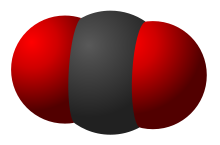pCO2

pCO2,pCO2,oris thepartial pressureofcarbon dioxide(CO2), often used in reference tobloodbut also used inmeteorology,climate science,oceanography,andlimnologyto describe the fractional pressure of CO2as a function of its concentration in gas or dissolved phases. The units ofpCO2aremmHg,atm,torr,Pa,or any other standard unit ofatmospheric pressure.ThepCO2ofEarth'satmosphere has risen from approximately 280 ppm (parts-per-million) to a mean 2019 value of 409.8 ppm as a result ofanthropogenicrelease of carbon dioxide fromfossil fuelburning. This is the highest atmospheric concentration to have existed on Earth for at least the last 800,000 years.[1]
Medicine
[edit]In medicine, the partial pressure of carbon dioxide inarterial bloodis calledorPaCO2.Measurement ofin thesystemic circulationindicates the effectiveness ofventilationat the lungs'alveoli,given thediffusing capacityof the gas. It is a good indicator of respiratory function and the closely related factor ofacid–base homeostasis,reflecting the amount of acid in the blood (without lactic acid). Normal values for humans are in the range 35–45mmHg.Values less than this may indicatehyperventilationand (if bloodpHis greater than 7.45)respiratory alkalosis.Values greater than 45 mmHg may indicatehypoventilation,and (if blood pH is less than 7.35) respiratoryacidosis.[2][3]
Aquatic sciences
[edit]Oceanographers and limnologists usepCO2to measure the amount of carbon dioxide dissolved in water, as well as to parameterize itsfluxinto (influx) and out of (efflux) the atmosphere. Carbon dioxide reacts with water to formbicarbonateandcarbonateions, such that the relative solubility of carbon dioxide in water is greater than that of other unreactive gasses (e.g.Helium). As more carbon dioxide dissolves in water, itspCO2rises until it equals thepCO2of the overlying atmosphere. Conversely, a body of water with apCO2greater than that of the atmosphere effluxes carbon dioxide.[4][5]
pCO2is additionally affected by watertemperatureandsalinity.Carbon dioxide is less soluble in warmer water than cooler water, so hot water will exhibit a largerpCO2than cold water with the same concentration of carbon dioxide.pCO2can be used to describe the inorganic carbon system of a body of water, together with other parameters such as pH,dissolved inorganic carbon,andalkalinity.Together, these parameters describe the concentration and speciation of inorganic carbon species (CO2 (aq),HCO3−,CO32-) in water.[5]
Biological processes such asrespirationandphotosynthesisaffect and can be affected by aquaticpCO2.Respiration degradesorganic matter,releasing CO2into the water column and increasingpCO2.Photosynthesis assimilates inorganic carbon, thereby decreasing aquaticpCO2.[4]
See also
[edit]- Acidosis
- Alkalosis
- Arterial blood gas
- Blood gas tension
- Chemical equilibrium
- Hypercapnia
- pH
- Carbon Cycle
- xCO2
References
[edit]- ^Lindsey, Rebecca (2020)."Climate Change: Atmospheric Carbon Dioxide".climate.gov.Retrieved2021-02-25.
- ^Dugdale DC, Zieve D. Gasometría arterial. Medline Plus. 09/01/2012.
- ^Leticia Godoy Dias Sanderson. Gasometria arterial - Artigo de revisão. Fevereiro 2012.Archived2014-10-17 at theWayback Machine
- ^abMillero, Frank J. (2013).Chemical oceanography(4 ed.). Boca Raton: Taylor & Francis.ISBN978-1-4665-1255-9.OCLC958798815.
- ^abZeebe, Richard E. (2001).CO2 in seawater: equilibrium, kinetics, isotopes.Dieter A. Wolf-Gladrow. Amsterdam.ISBN978-0-08-052922-6.OCLC246683387.
{{cite book}}:CS1 maint: location missing publisher (link)
![]() This article incorporatestextby Glynda Rees Doyle and Jodie Anita McCutcheon available under theCC BY 4.0license.
This article incorporatestextby Glynda Rees Doyle and Jodie Anita McCutcheon available under theCC BY 4.0license.


